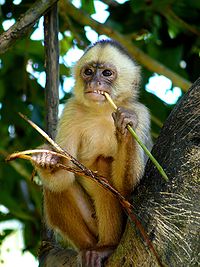Cebidae
| Cebidae Late Oligocene[1] to present
| |
|---|---|

| |
White-headed capuchin (Cebus capucinus)
| |
| Scientific classification | |
| Domain: | Eukaryota |
| Kingdom: | Animalia |
| Phylum: | Chordata |
| Class: | Mammalia |
| Order: | Primates |
| Suborder: | Haplorhini |
| Infraorder: | Simiiformes |
| Parvorder: | Platyrrhini |
| Family: | Cebidae Bonaparte, 1831 |
| Type genus | |
Cebus
, 1777 | |
| Genera | |
| |
The Cebidae are one of the five
New World monkeys now recognised. Extant members are the capuchin and squirrel monkeys.[3] These species are found throughout tropical and subtropical South and Central America
.
Characteristics
Cebid monkeys are
brown capuchin
, with a body length of 33 to 56 cm, and a weight of 2.5 to 3.9 kilograms. They are somewhat variable in form and coloration, but all have the wide, flat, noses typical of New World monkeys.
They are omnivorous, mostly eating fruit and insects, although the proportions of these foods vary greatly between species. They have the dental formula:2.1.3.2-32.1.3.2-3
Females give birth to one or two young after a gestation period of between 130 and 170 days, depending on species. They are social animals, living in groups of between five and forty individuals, with the smaller species typically forming larger groups. They are generally diurnal in habit.[4]
Classification
Previously, New World monkeys were divided between
Aotidae, Pitheciidae and Atelidae.[2] The most recent classification of New World monkeys again splits the callitrichids off, leaving only the capuchins and squirrel monkeys in this family.[3]

- Subfamily Cebinae(capuchin monkeys)
- Genus Cebus(gracile capuchin monkeys)
- Colombian white-faced capuchin or Colombian white-headed capuchin, Cebus capucinus
- Panamanian white-faced capuchin or Panamanian white-headed capuchin, Cebus imitator
- Marañón white-fronted capuchin, Cebus yuracus
- Shock-headed capuchin, Cebus cuscinus
- Spix's white-fronted capuchin, Cebus unicolor
- Humboldt's white-fronted capuchin, Cebus albifrons
- Guianan weeper capuchin, Cebus olivaceus
- Chestnut capuchin, Cebus castaneus
- Ka'apor capuchin, Cebus kaapori
- Venezuelan brown capuchin, Cebus brunneus
- Sierra de Perijá white-fronted capuchin, Cebus leucocephalus
- Río Cesar white-fronted capuchin, Cebus cesare
- Varied white-fronted capuchin, Cebus versicolor
- Santa Marta white-fronted capuchin, Cebus malitiosus
- Ecuadorian white-fronted capuchin, Cebus aequatorialis
- Genus Sapajus(robust capuchin monkeys)
- Tufted capuchin, Sapajus apella
- Blond capuchin, Sapajus flavius
- Black-striped capuchin, Sapajus libidinosus
- Azaras's capuchin, Sapajus cay
- Black capuchin, Sapajus nigritus
- Crested capuchin, Sapajus robustus
- Golden-bellied capuchin, Sapajus xanthosternos
- Genus
- Subfamily Saimiriinae(squirrel monkeys)
- Genus Saimiri
- Bare-eared squirrel monkey, Saimiri ustus
- Black squirrel monkey, Saimiri vanzolinii
- Black-capped squirrel monkey, Saimiri boliviensis
- Central American squirrel monkey, Saimiri oerstedi
- Guianan squirrel monkey, Saimiri sciureus
- Humboldt's squirrel monkey, Saimiri cassiquiarensis
- Collins' squirrel monkey, Saimiri collinsi
- Genus
Extinct taxa
- Genus Panamacebus
- Panamacebus transitus
- Subfamily Cebinae
- Genus Acrecebus
- Acrecebus fraileyi
- Genus Killikaike
- Killikaike blakei
- Genus Dolichocebus
- Dolichocebus gaimanensis
- Genus Acrecebus
- Subfamily Saimiriinae
- Genus Saimiri
- Genus Patasola
- Genus
References
Wikispecies has information related to Cebidae.
- PMID 10640951.
- ^ OCLC 62265494.
- ^ ISBN 978-0-387-78704-6.
- ISBN 0-87196-871-1.
